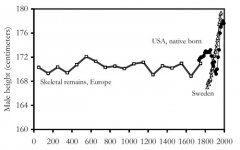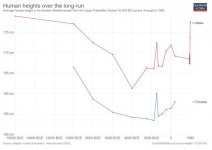Slavic ethnogenesis is older than that - at least 3000 years ago.
Kuschniarevich et al. 2015 estimated Slavic ethnogenesis at around 3500-2500 years ago:
(...) There is a near consensus among linguists that the Baltic and Slavic languages stem from a common root, Proto-Balto-Slavic, which separated from other Indo-European languages around 4,500–7,000 years before present (YBP) [1–8] and whose origin is mapped to Central Europe [8]. The Balto-Slavic node was recognized already in the pioneer Indo-European[9]. The split between Baltic and Slavic branches has been dated to around 3,500–2,500 YBP [6–8]. (...)"
They also estimated first divisions of Proto-Slavs into branches at around 1900 years ago:
"(...) Our consensus tree (Fig. G in S2 File) suggests the following topological and temporal reconstruction of the Balto-Slavic languages. Initial disintegration of proto-Balto-Slavic into proto-East Baltic and proto-Slavic took place during the 2nd millennium BC. Proto Slavic splits into 3 major clades, East, West, South Slavic around year 100 AD (1900 Years Before Present). Further diversification of each clade into minor clades (i.e. proto-East Slavic: Ukrainian/Belarusian, Russian; proto-West Slavic: Czech/Slovak, Sorbian, Polish/Kashubian; proto-South Slavic: Serbo-Croatian, Bulgarian, Macedonian) took place during the 5th–7th centuries AD (about 1500–1300 YPB), followed by final shaping of individual languages (1000–500 YBP). (...)"
As for R1a, I did some research and it seems that Balts also have a fair share of R1a-CTS3402. I think it will be extremely difficult to distinguish Slavic from Baltic R1a subclades, we would have to split hairs and count percentages of deep subclades.
I'm not sure if it helps, but here are some FTDNA kits with ancestry from East Prussia with R1a:
1. Subclades common among East Balts:
Origin of surname kit number R1a subclade:
German kit 329192 - Z92>Z685>YP270>YP351>Y16755>YP4296
German kit 221446 - Z92>Z685>YP270>YP351>Y9081>YP350
German kit 162556 - Z92>Y4459>YP5520
Polonized German kit N2278 - Z92>Y4459>YP617>YP1700
German (?)* kit 71994 - CTS1211>YP1034>YP4258
German kit 85285 - CTS1211>Y35>CTS3402>YP237>YP235>YP234>YP295>L366>Y P5223
German kit 175710 - CTS1211>Y35>CTS3402>Y33>CTS8816>Y2902>Y2910>Y2915
Unknown kit E10339 - CTS1211>Y35>CTS3402>YP237>YP951>Y17619
Unknown kit N43077 - Z92+
Polish kit 426239 - CTS1211>Y35>CTS3402>Y33>YP968>YP969>YP4335
Polish kit 157553 - Z92>Z685>YP270>YP351>Y9081>YP350
Polish kit 161829 - S24902>YP561>YP4094>YP4078
Polish kit E4688 - Z92+
*Pallaschke, sounds German but could be Germanized of Slavic origin.
2. Subclades common among Kashubians:
Origin of surname kit number R1a subclade:
German kit 165792 - CTS1211>Y35>CTS3402>YP237>YP235>YP234>YP238>L365>Y P243>YP389>YP4669
German kit N7393 - CTS1211>Y35>CTS3402>YP237>YP235>YP234>YP238>L365>Y P243
Polish kit E9666 - CTS1211>Y35>CTS3402>YP237>YP235>YP234>YP238>L365>Y P243>YP269>Y6956>L670
3. Subclades common among East Slavs:
Surname kit number R1a subclade:
Czeranna kit 316853 - Z92>Y4459>YP617>YP573>YP569>YP682
Skubinna* kit 415060 - Z92>Y4459>YP617>YP573>YP569>YP1256>YP4846
Glass kit 175710 - CTS1211>Y35>CTS3402>Y33>CTS8816>Y2902>Y2910>Y2915
*Apparently a Lithuanian surname, although they came from Russia?:
Skubinna said:
there was some interest in my surname, Skubinna. My FTDNA Kit is #415060/R1a-YP569.
Testing indicates the family goes back to the Ryazan Oblast of Russia in the 1500s. In 1600, they were living in Latvia. At some point after that year, they were Lithuanians living in Lithuania Minor which when it became part of Germany was known as East Prussia. According to the language experts at the Library of Congress, the name Skubina/Skubinna is Lithuanian and means "to be in a hurry" or "to be quick." My direct ancestor was Petras/Peter Skubinna. In 1720 he was paying land taxes at Loyen (near Dubeningken) in Kreis/County Goldap, East Prussia. His sons all had Lithuanian Christian names until the 1730s. if any one would like more information on my family's heritage or an article on the history of Lithuania Minor feel free to email me at mskubinna at yahoo.
As far as I can tell from the church records going back to the 1730, a few of my Skubinna relatives were still using Lithuanian names as late as the 1840s. None after that date. My paternal Great-Grandfather came to the U.S.A. in 1885. He only spoke German, but because he originally engaged in timbering in Michigan he had Swedish employees and learned that language. In 1892, he move to North Dakota and became a prosperous rancher. He hired fellow Germans and a number of Russian men and women to work for him raising wheat. So he also learned enough Russian to be able to work with them.
4. Other samples of R1a from East Prussia:
Origin of surname kit number R1a subclade:
Polish kit N1840 - M458>PF7521>L260>YP256>YP254>Y4135>Y14244
Jewish? (Rosenbaum) kit B14462 - M458>PF7521>CTS11962>L1029>YP263>Y2921>Y2914>Y20359
German kit 145992 - M458+
Germanized Slavic kit 31553 - M458>PF7521>L260+
Polish kit N5198 - M458>PF7521>CTS11962>L1029+
German kit 137403 - M458>PF7521>CTS11962>YP515
Germanized Slavic kit 200664 - CTS1211>Y35>CTS3402>Y33>CTS8816>S18681>YP315>YP314
Polish kit N18451 - CTS1211>YP343>YP340
German kit 153224 - CTS1211>Y35>CTS3402>Y2613
German kit 275076 - CTS1211>Y35>CTS3402>Y2613>Y2609>Y2608>YP613
Germanized Slavic kit 330940 - CTS1211>Y35>CTS3402>Y33>CTS8816>L1280>FGC19283>YP1448
Polish kit E4464 - CTS1211>Y35>CTS3402>Y33>CTS8816>L1280>FGC19283>YP1448>FGC19273
Polish kit 2546 - CTS1211>Y35>CTS3402>Y33>CTS8816>S18681>Y12463 >YP1428*
Polish kit 131361 - CTS1211>Y35>CTS3402>Y33>CTS8816>Y2902>Y3226>Y 3219>YP1144>PH3519-B2
Low resolution of Y-SNPs:
Origin of surname kit number R1a subclade:
German kit E6115 - M512+
Polish kit E10941 - M198+
German kit E2656 - M198+
German kit N2864 - M417+
German kit 145455 - M417+
=====
Haplogroup I2a in East Prussia, here mostly surnames of Slavic origin:
kit E2677 Karl L.
Nath born in year 1820 in Osterode (Ostróda)
kit B1542 Gottfried
Golembiewski, born in 1790 in Riesenburg (Prabuty)
kit E7698 Michael
Rimek born in 1723 in Ortelsburg (Szczytno)
kit N4664 Adalbert
Rutkowski, born in 1730 in Grutta (Gruta)







